
How to Create a Great Table of Specification (TOS)/Test Blueprint
Introduction to How to Create a Great Table of Specification (TOS)/Test Blueprint
How to Create Expert Table of Specification (TOS) or Test Blueprint provides a step-by-step guide on how to create a standard TOS.
What is a table of specification (TOS) in education? Is a test blueprint the same thing as a table of specifications? What is the importance of a table of specification (TOS) or test blueprint? How can you create a standard table of specifications?
All these are the questions that I will answer in this guide.
What is a table of specifications in simple language?
A table of specifications (TOS) is a document like a lesson plan that a teacher prepares to guide him/her on how to conduct an assessment or set assessment questions that appropriately cover the important topics as recommended in the curriculum and covered in class.
A table of specifications may only be a single page or a few pages. Although different schools may have their unique format of table of specifications, teachers mostly create TOS in rows and columns.
This is why many teachers use spreadsheet software like Microsoft Excel to create their table of specifications. Some tables of specifications are simple while others are more complex. You may prepare a table of specifications for a term or shorter period of time.
Is a Table of Specifications (TOS) the same as a Test Blueprint?
Absolutely. Test blueprint is another term for a table of specifications.
What is the content or component of a table of specifications or test blueprint?
Generally, a Table of Specifications (TOS) or Test Blueprint typically includes two main components: content areas and cognitive levels.
However, for the purpose of this guide, we will divide the two major components into simpler units.
A standard table of specification (TOS) or test blueprint should contain the following:
- Class
- Subject
- Assessment Period
- Academic Year
- Topic
- Time Spent/Frequency
- Weight Average
- Competencies – objectives
- Cognitive Level or Classification of Objective
- Question Grouping
- Total Number of Questions
What does a Table of Specifications (TOS) or Test Blueprint tell the Supervisor? Why is a Test Blueprint important?
Before we look at how to create a TOS, let us, first of all, see what your TOS tells your supervisor. Once you know what the supervisor will be looking for, you will be in a better position to create a TOS that answers all the questions.
By simply studying your one-page TOS, your supervisor or any experienced teacher can tell the type of teacher you are in the classroom. This is why TOS is very important.
Not just for the supervisor, but a TOS can help the teacher become more effective. Here are the TOS say about a teacher or a class:
Alignment with Curriculum
Have you ever heard any student complain that a teacher did not teach them what s/he set in an examination? A TOS or test blueprint helps to prevent a teacher from falling that way. More importantly, it vindicates a teacher in case of such an allegation.
This is one of the major things a supervisor looks for in the TOS or test blueprint. They compare to see if you have taught what the curriculum stipulates. In other words, do your topics correspond to the curriculum? In addition, they check if your questions measure the areas stated in the standard curriculum.
Hence, it is only professional for teachers to create TOS to guide them from derailing.
Balance of Content
Another thing that your TOS reveals is how you balance your lessons with your tests. Unquestionably, we know some teachers indulge in the unprofessional practice of setting questions they did not teach in class.
That is why there are frequency and weight average components in every TOS. These components make a teacher accountable by making them think of how many times or how much time they spent on a particular topic and how much importance they assigned to each.
Then again, from the perspective of the teacher, the components help you set questions according to the amount of time you spent/the importance of each topic.
I have seen teachers who concentrated their entire questions on a single less important topic.
Once a supervisor peruses a TOS, s/he can tell if you gave appropriate emphasis to the various content areas in the assessment and if you did not over-represent or under-represent a topic.
Question Appropriateness
Yes, this too happens. Teachers set questions that are either far beyond or below the abilities of the students they are assessing.
TOS helps teachers to categorise the objectives/questions according to the cognitive demands that the students require to answer them. Furthermore, it helps teachers to determine the appropriate type of question that is best suited for each item.
This way, once a supervisor analyzes a TOS, he or she can tell the level of difficulty of the assessment and ensure that it is appropriately challenging for students.
Validity and Reliability
Finally, a TOS can provide important information about the validity and reliability of the assessment. By ensuring that the assessment is aligned with the curriculum, balanced in terms of content coverage, and appropriately weighted, educators and supervisors can determine the validity and reliability of the assessment.
How to Create a Great Table of Specification (TOS)/Test Blueprint
Now that we have discussed the components and importance of a table of specifications (TOS) or test blueprint, let us see how to create one.
Formats of Table of Specifications (TOS) /Test Blueprint
Before we get to work, you have to understand that there are different formats of the table of specifications (TOS) or test blueprints. The two basic formats are:
- One-Way Table of Specification or Test Blueprint Format
- Two-Way Table of Specification or Test Blueprint Format
Both of these formats are similar. The only difference is in their complexities. While the one-way format is simple with streamlined features, the two-way format contains all the components of a standard TOS.
Generally, I recommend the one-way format for the Basic education levels up to JSS 2 and the two-way format for more advanced learners starting from JSS 3 upward.
Let how to create a great table of specification (TOS) / test blueprint in the one-way format.
How to Create a Great Table of Specification / Test Blueprint in One-Way Format
- Appropriately Title The TOS – the name of the school, class, subject, academic year and examination
- Draw a table with four columns
- Title the columns as Topic/Objective, Frequency (Days/Hours), Number of Questions and Question Grouping from left to right.
- List out the topics or/and objectives in the first column, one per row.
- Look up your lesson plan or timetable and write the number of days or hours you spent teaching each topic or objective under the frequency column corresponding to each topic.
- Determine the total number of questions you intend to set in the test or exam
- Divide the total number of intended questions by the total frequency then multiply the answer by the frequency of each topic to get the number of questions per topic. After that, write the number of questions for each topic in the same as the topic under the third column (Number of Questions).
- Finally, write out the set of question numbers that cover each topic in the last column.
Titling a Table of Specifications (TOS) or Test Blueprint
The first step in creating a table of specification (TOS) or test blueprint is to title it. In the blank sheet on which you want to create a TOS, write the name of the school, class, subject, academic year and the examination/grading period for which you are preparing the TOS. The examination may be the mid-term continuous assessment, the end-of-term examination, the mock examination or the end-of-the-year examination. See a sample below (click or tap on the image to see a larger view).
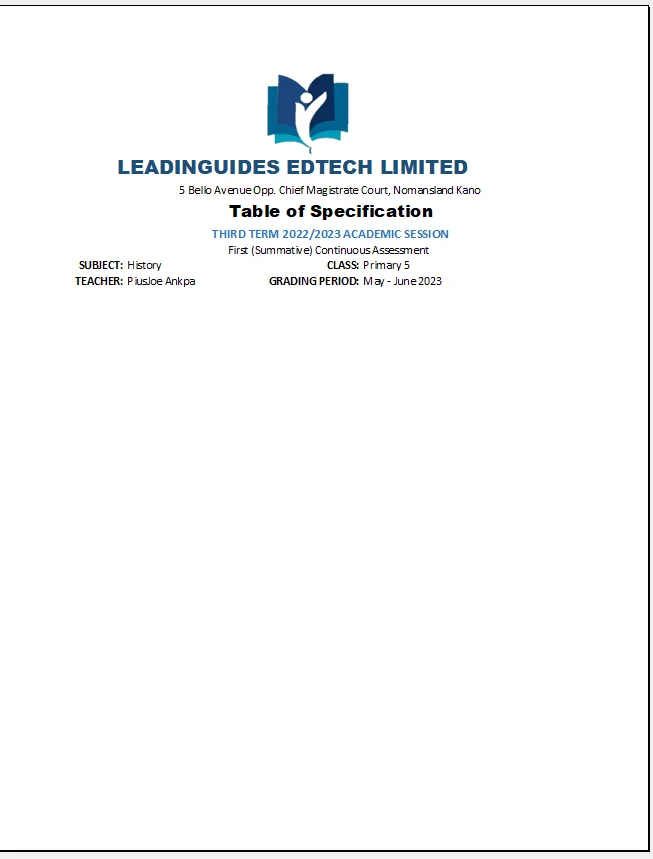
Draw a table with four columns
After you have titled your TOS, the next step is to draw the layout. The layout for a one-way TOS format is simple, a table of four columns.
Now, draw and title the table and columns as below. Click or tap the image to see full size.
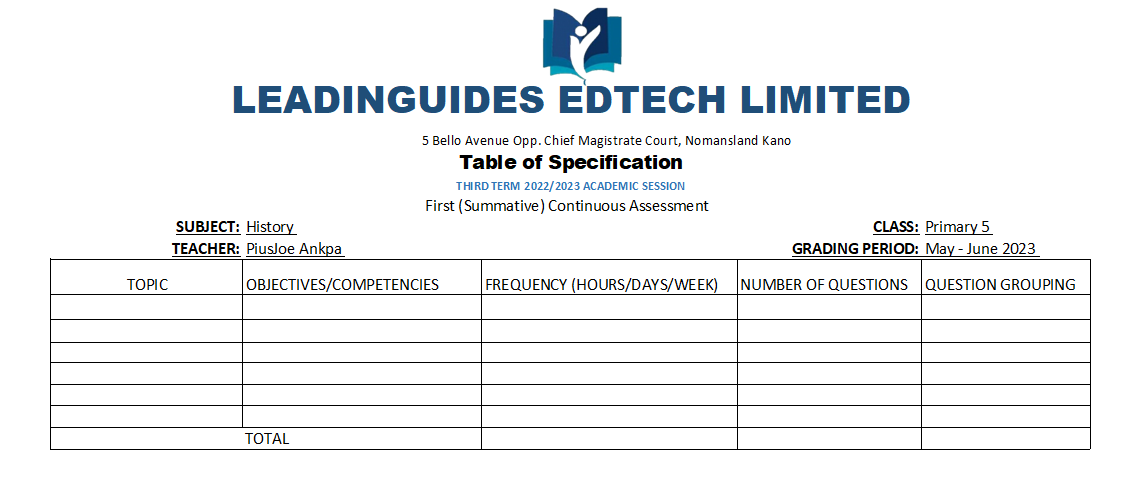
Content Areas – Topic and/or Objectives
After drawing the TOS layout, the next step is for you to list out the topics or/and objectives in the first (two) column(s), one per row.
In this demo, I will create a one-way TOS for History Primary 5. The TOS is for the first summative Continuous Assessment (CA). Since the first CA usually takes place within the first six weeks of resumption, this sample TOS covers the topics within the same period.
After determining the period for your assessment, the next step is to get topics and/or objectives or competencies for the period. To do this, you have to look at your scheme of work or curriculum.
One of the qualities of every good scheme of work is that it should contain the objectives for each topic. I am sure you have a good scheme. If you are not sure, click on this link to check our official schemes of work.
Now for this demonstration, I want to create a sample TOS for History Primary 5. Hence, I checked the Primary 5 History scheme of work to get the topic and the objectives for the first six weeks of the third term.
After obtaining the topics covering the first six weeks, I listed them on the TOS as shown below.
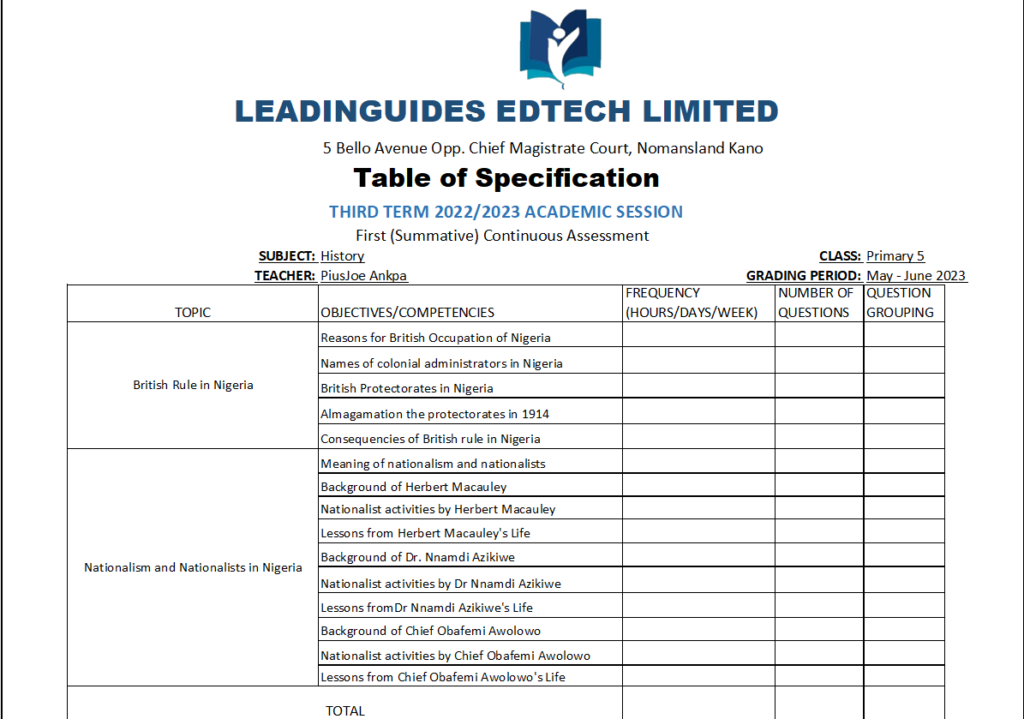
If you notice, from the table above, there are only two topics spread across the first six weeks in the History curriculum for Primary 5. Under the competencies, you can also see that the first and second topics have 5 and 10 key areas respectively.
Also, I added a total row at the end of the table. If you are following this guide to create your first TOS, please add the total row as well.
Please note that the layout of the topics and competencies may vary depending on your school and the level. As I said earlier, this format is better suited for the elementary level where the content areas are not bulky.
We will cover the layout for higher levels in the second format.
Frequency (Hours/Days)
So now we have written out our topics and competencies on our developing TOS. The next step is to write the frequency for each topic/competency.
The frequency of a topic or competency in a TOS or test blueprint is how often you treated the topic in class with your students. This may be the number of hours or days.
But how do we get the frequency for a topic? Simple, here’s how:
Ordinarily, you should be able to get the number of times or hours you spent on a topic from your record of work or dairy. This is the ideal way of knowing how much time you spent treating a particular topic.
However, if for certain circumstances, you do not have or properly keep a record of work/dairy – and I have seen teachers who don’t, you can still work out the “estimated” frequency.
Since I did not actually teach History in primary 5 for which I am creating the sample TOS, I will use this estimated frequency method.
How to calculate the frequency of topic
Check your lesson timetable, lesson plan or lesson note, and scheme of work to find out and write out the following:
- The number of periods the subject for which you are creating TOS appear on the timetable.
- Duration of each period on the timetable.
Now do the Maths:
Assuming History (the subject for which you are creating TOS) is assigned 4 periods a week, and the duration of each period is 30 minutes; This means the total amount of time for the subject per week is 4 × 30 minutes = 120 minutes or 2 hours.
If you are creating TOS for the entire term, note that you are to multiply the total time per week by 10, 11, 12 or 13 because there are between 10 to 13 teaching weeks per term.
After getting the total amount of time for the subject per week, you have to get the total amount of time for each topic. Do this starting with the topic and then the objectives.
First, check the scheme of work to know the number of weeks allocated to each topic.
Then, to get the duration of each topic, multiply the total amount of time for the subject per week by the number of weeks allocated to each topic.
In my sample, the first topic is allocated 2 weeks in the scheme and the second topic is allocated 3 weeks (the first week is for revision).
So, the duration of the first topic is 2 (total subject hours per week) × 2 (number of weeks allocated to the topic in the scheme). This gives 4 hours. That is the total amount of time I spent or will spend on the first topic. That is also the frequency which I will write on the TOS.
Similarly, for the second topic, the duration is 2 (total subject hours per week) × 3 (number of weeks allocated to the topic in the scheme). This gives 6 hours. Also, it is the total time I spent or will spend teaching the second topic. This is also the frequency which I will write on the TOS.
Now Frequency of Each Competency
Remember that each topic is divided into many objectives. So, you have to equally distribute the total time for each topic to the various objectives. Once again, you are expected to have taught a subject before you draw a TOS for it. But if for excusable reasons you want to create a TOS ahead of actual delivery, then you can set the duration of each objective rather arbitrarily/randomly.
Regardless of that, there are a few things to note. First, the sum of the time you allocate to a set of objectives should not exceed the total amount of time you should spend on the topic under which those objectives fall.
For example, in my demo TOS, the first five objectives are under the first topic. And we have estimated that the total time for the first topic is 4 hours. So, whatever duration I choose to randomly assign to the first five objectives must not be more than 4 hours.
Another point to guide how you randomly assign time to lesson objectives is the importance or relevance of the objectives. Two things determine the importance or relevance of the objective. First is how useful/applicable the objective is to the everyday life of the students. And second, is the prevalence of the objective in standardized/external examinations like common entrances for primary, BECE for JSS and SSCE for SSS.
Finally, consider how long it will take you to adequately treat the objective in class.
Based on these criteria, assign the time for each objective. Doing so gives a progressive look of the demo Table of Specification (TOS) or test blueprint as below.
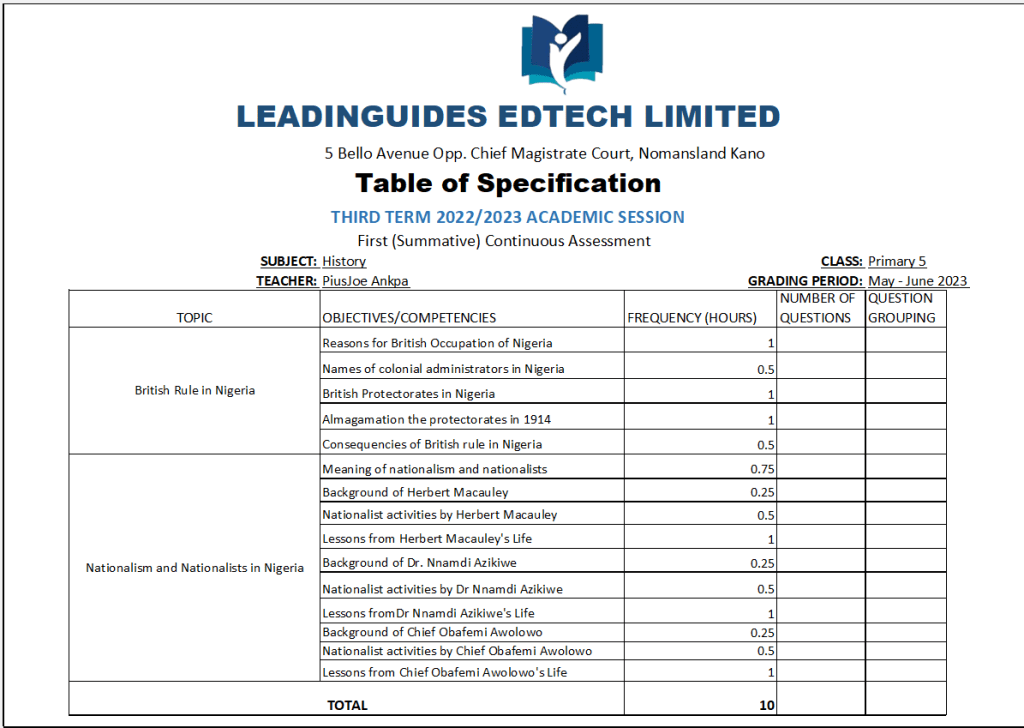
Determining the Number of Questions in the Test/Exam
After you have determined the frequency or duration of each topic/competency, the next step is to choose the total number of questions you intend to set in the test or examination.
This is simple. You can choose any number of questions that you deem suitable. In fact, in almost every school, the administrator or examination committee will tell you the format of the questions.
Notwithstanding, it is important to note that the standard of questions in a continuous assessment or mock examination should reflect how the final examination will look like.
As I pointed out in How to Conduct a Standard Examination in Nigeria, many schools and teachers conduct examinations that are convenient for them instead of how they should be.
This is wrong and you should not do it. In every test or examination, let the nature of the exam meet the goals.
That said, in this continuous assessment test that we are creating a TOS for, I have decided to set 20 questions, 15 multiple choice and 5 essay questions.
I will write this in the total row under the number of questions column as shown below:
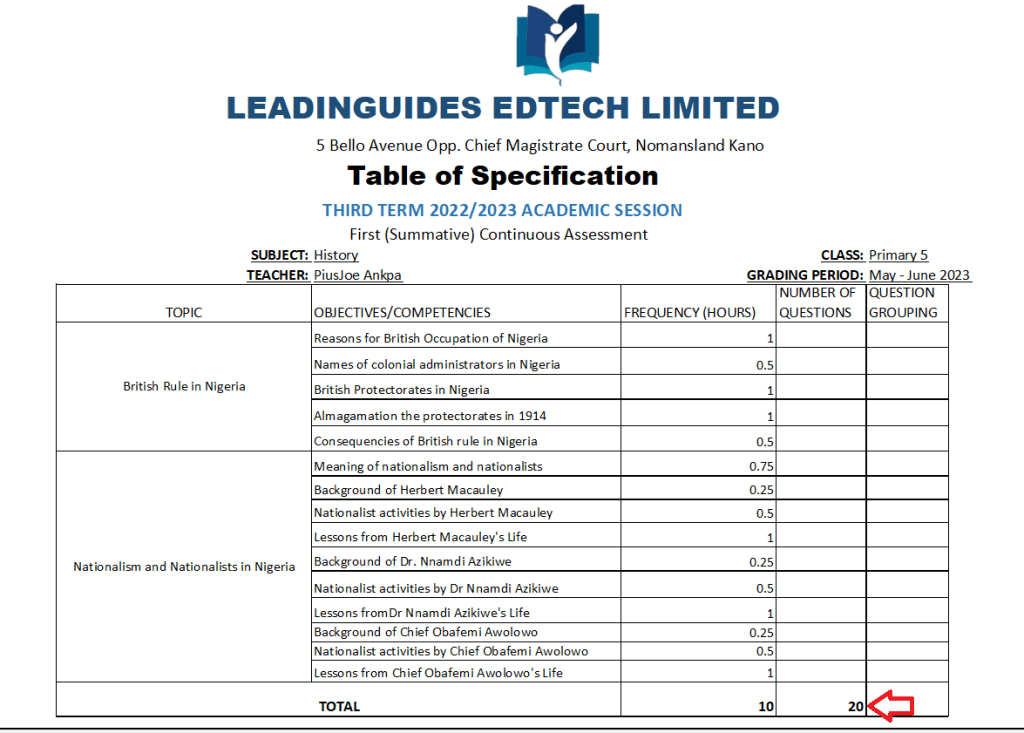
Determine the Number of Questions Per Topic
Now you know the total number of questions you intend to set for the test/examination. As I discussed earlier, one of the purposes of a TOS is to ensure a balance between what you treated in the class and what you set in the test. Hence, topics you gave more time and attention to in class must have more questions in the test.
More so, you cannot concentrate all your questions around a single topic. Instead, the questions must be evenly spread across the topic.
Fortunately, there is a mathematical approach to inform this.
The formula is to divide the total number of intended questions by the total frequency then multiply the answer by the frequency of each topic.
For example, in the sample TOS we are creating, we intend to set a total of 20 questions and the total frequency is 10 (hours). So, to determine the number of questions we are supposed to set from each topic/competency, we will divide the intended total questions (20) by the total frequency (10). This gives us 2.
From there we will multiply the answer (2) by each of the time allocated to the competencies.
For the first competency (Reasons for British Occupation of Niger), the time allocated is 1 hour. The number of questions covering that area in the test is 2 × 1 = 2 questions.
For the second competency (Names of Colonial Administrators in Nigeria), the time allocated is 0.5 hours or 30 minutes. The expected number of questions to cover that area in the test is 2 × 0.5 = 1 question.
Doing this for all the competencies give the table below:
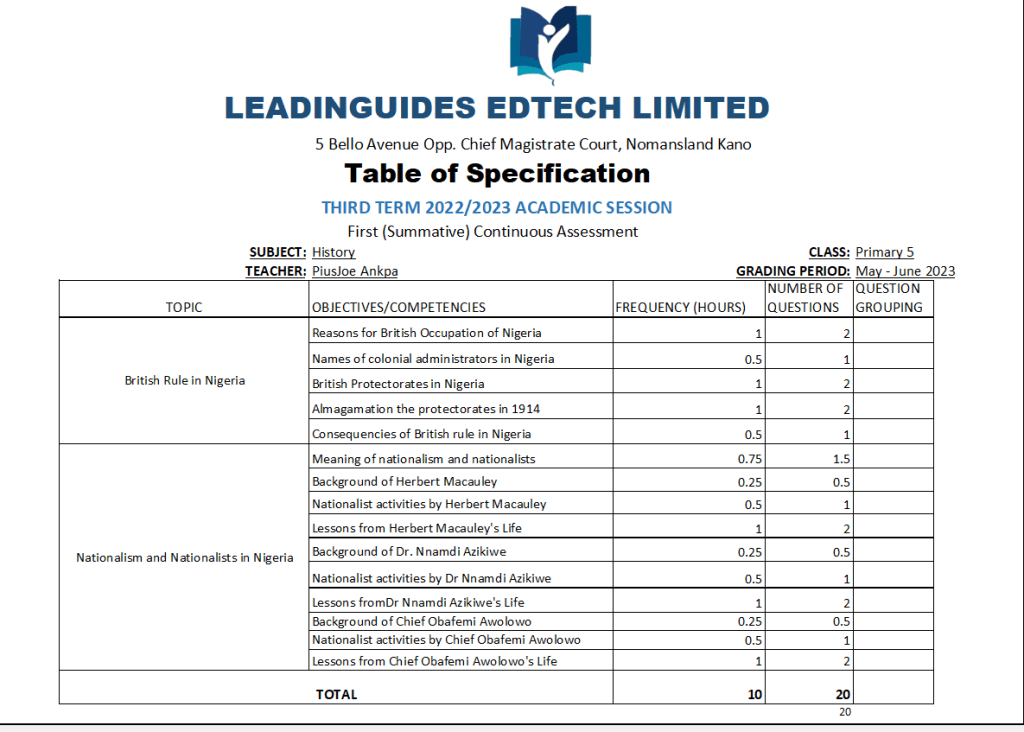
If you look carefully, you will notice that there are fractions in the number of questions. For example, “Meaning of nationalism and nationalist” has 1.5 questions and “Background of” the nationalists also carries 0.5 questions.
But we cannot set half question from. What you do is round and merge selected figures as you deem fit. However, ensure that the question numbers sum up to the total you selected earlier.
Below is my final rendering of the TOS.
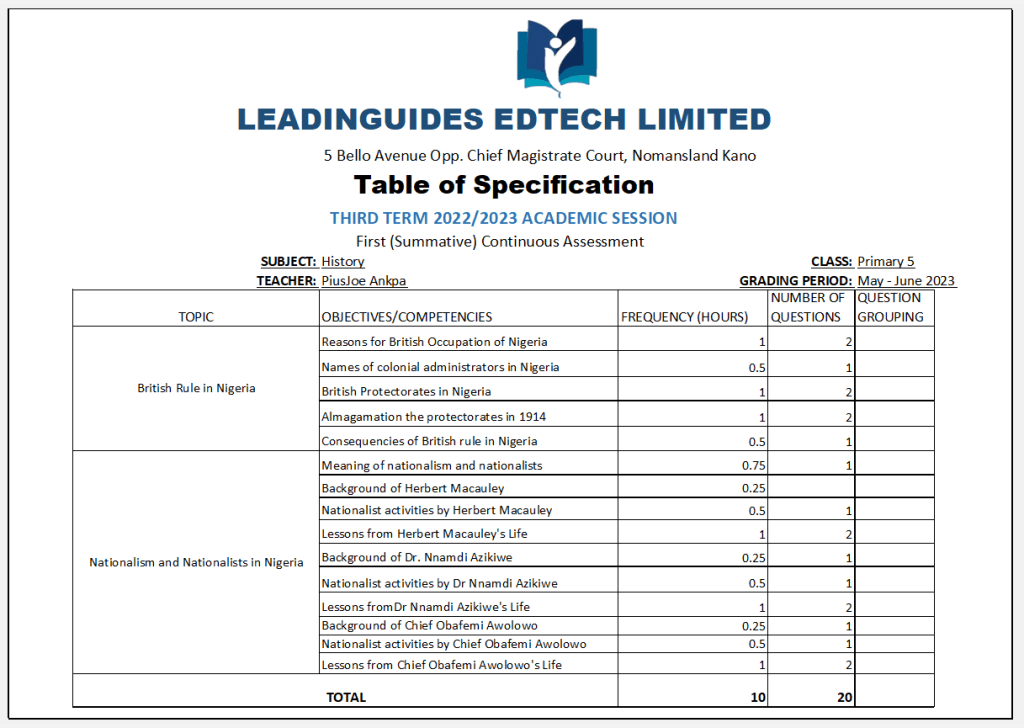
Incidentally, I chose to not set any questions covering the background of Herbert Macaulay. I also rounded the number of questions on nationalism and nationalist to 1.
Question Grouping
We have now almost completed our TOS or test blueprint. The last thing left is to write out the question grouping.
This is how you plan to arrange the questions. For instance, we have decided to set two questions covering the “Reasons for British Occupation of Nigeria”, but we have not decided which question numbers in the test these two questions will be. Will it be questions number 1 and 2, 2 and 4, 10 and 20, or what?
Tests that you space questions from the same topic apart tend to require higher remembering skills, hence more difficult. For Lower Basic, I recommend arranging questions from the same topic in succession as this provides cues for the pupils.
However you decide to arrange your questions, write them out in the last column of the one-way TOS format and you have your complete one-way Table of Specification (TOS) or Test Blueprint.
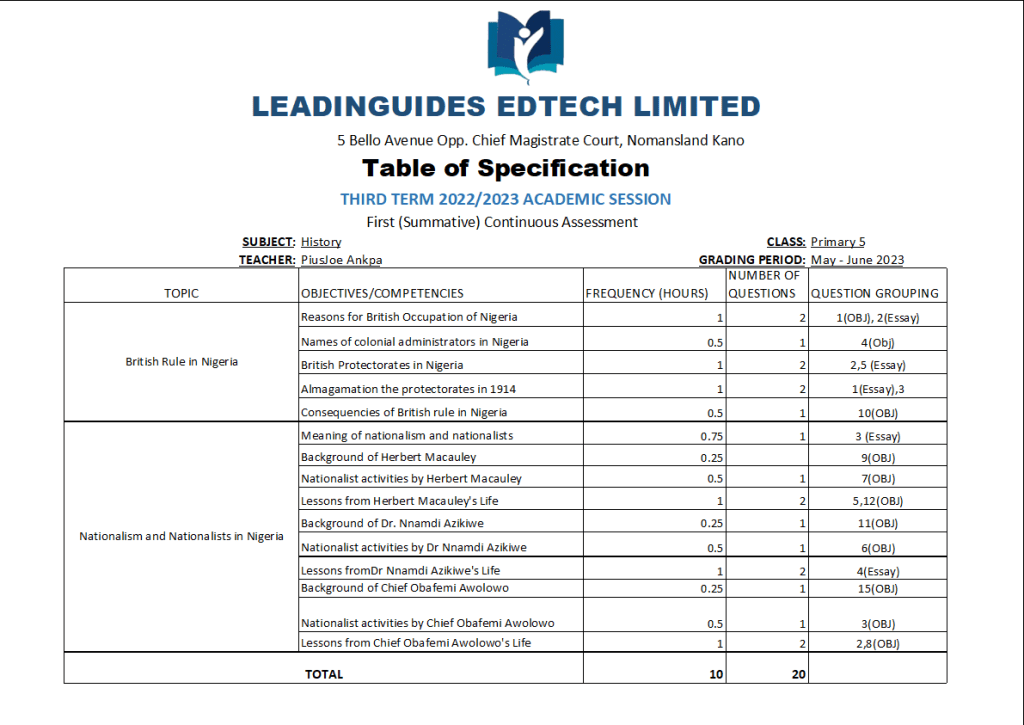
Conclusion
In this guide, we discussed the meaning of a table of specifications or a test blueprint and saw some reasons why it is important to have one for every test/examination you conduct as a professional teacher.
We learned that there are basically two formats of a TOS although the different schools may have different designs. We followed a step-by-step guide and we created a sample table of specifications based on the one-way format.
In a subsequent post, we will create a sample of TOS based on the two-way format. Let me know what you think in the comment box.
Works Consulted
Abadines, A. (n.d.). How to create a Table of Specifications (TOS) in 5 Easy Steps. Academia. Retrieved from https://www.academia.edu/33665595/How_to_create_a_Table_of_Specifications_TOS_in_5_Easy_Steps
Admin, G. A. (2019, August 4). Table of Specification Template. Retrieved from Guru Ako: http://guroako.com/2019/08/04/table-of-specification-template/
Alade, O., & Omoruyi, I. V. (2014, March). TABLE OF SPECIFICATION AND ITS RELEVANCE IN EDUCATIONAL DEVELOPMENT ASSESSMENT. European Journal of Educational and Development Psychology, 1-17. Retrieved from https://www.eajournals.org/wp-content/uploads/Table-of-Specification-and-its-Relevance-in-educational-development-Assessment.pdf
Moreno, R. (2022). One-Way Table of Specification Simple Explanation, Example and Procedure. Retrieved from YouTube: https://www.youtube.com/watch?v=jaXaxNFM3Jk
Moreno, R. (2022). Two Way Table of Specification- Simple Explanation, Example and Procedure. Retrieved from YouTube: https://www.youtube.com/watch?v=nTJDe744Se0
The University of Kansas. (n.d.). Table of Specifications. Retrieved from The University of Kansas: https://specialconnections.ku.edu/assessment/quality_test_construction/teacher_tools/table_of_specifications
Discussions
Log in below to have your reviews and comments appear instantly.
Related Guides You May Also Like
Closing Attendance Register Termly
This post, Closing Attendance Register Termly, in one sentence This post, Closing Attendance register termly; provides step-by-step guides on how to correctly close students’ attendance registers for every term. This guide is for schools and teachers that use the traditional (manual) attendance register. However, schools and teachers that use modern attendance system can also benefit […]
School Owner-Administrator Too Lenient? What to do
A school owner-administrator too lenient? Yes, some are; and “uncontrollably” so. The problem is that been too lenient has repercussions, negative ones – for the administrator, staff and the organization. So, when a school owner-administrator is too lenient; what is the right thing to do? In this post, I discuss just that. In addition, I […]
Automated Result Compilation Excel App
What is the Automated Result Compilation Excel App? This Automated Result Compilation Excel App is a Microsoft excel application that helps schools and teachers to quickly compile and prepare many students’ report cards at once. LeadinGuides created the automated result compilation excel app as alternative for low-cost schools who cannot afford the more complex online […]




